目前来看 Context 是一个非常强大但是很多时候不会直接使用的 api。大多数项目不会直接使用 createContext 然后向下面传递数据,而是采用第三方库(react-redux)。
想想项目中是不是经常会用到 @connect(...)(Comp) 以及 <Provider value={store}><App /></Provider>?
什么是 Context
Context 提供了一个无需为每层组件手动添加 props,就能在组件树间进行数据传递的方法。
一个顶层数据,想要传递到某些深层组件,通过 props 逐层传递将会非常繁琐,使用 Context 可避免显式地通过组件树逐层传递 props。
Context 使用示例
import React, { Component, createContext, useConText } from 'react'const ColorContext = createContext(null)const { Provider, Consumer } = ColorContext
console.log('ColorContext', ColorContext)console.log('Provider', Provider)console.log('Consumer', Consumer)
class App extends Component { constructor(props) { super(props) this.state = { color: 'red', background: 'cyan', } } render() { return <Provider value={this.state}>{this.props.children}</Provider> }}function Article({ children }) { return ( <App> <h1>Context</h1> <p>hello world</p> {children} </App> )}function Paragraph({ color, background }) { return ( <div style={{ backgroundColor: background }}> <span style={{ color }}>text</span> </div> )}function TestContext() { return ( <Article> <Consumer>{state => <Paragraph {...state} />}</Consumer> </Article> )}
export default TestContext
复制代码
页面呈现出的效果
打印 ColorContext、Provider、Consumer
createContext
// createContext 可以让我们实现状态管理// 还能够解决传递 Props drilling 的问题// 假如一个子组件需要父组件的一个属性,但是中间间隔了好几层,这就会出现开发和维护的一个成本。这时候就可以通过这个 API 来解决function createContext(defaultValue, calculateChangedBits) { var context = { ?typeof: REACT_CONTEXT_TYPE, _calculateChangedBits: calculateChangedBits, // As a workaround to support multiple concurrent renderers, we categorize // some renderers as primary and others as secondary. We only expect // there to be two concurrent renderers at most: React Native (primary) and // Fabric (secondary); React DOM (primary) and React ART (secondary). // Secondary renderers store their context values on separate fields. // 以下两个属性是为了适配多平台 _currentValue: defaultValue, _currentValue2: defaultValue, // Used to track how many concurrent renderers this context currently // supports within in a single renderer. Such as parallel server rendering. _threadCount: 0, // These are circular Provider: null, Consumer: null };
// 以下的代码很简单,就是在 context 上挂载 Provider 和 Consumer,让外部去使用 context.Provider = { ?typeof: REACT_PROVIDER_TYPE, _context: context };
var Consumer = { ?typeof: REACT_CONTEXT_TYPE, _context: context, _calculateChangedBits: context._calculateChangedBits };
context.Consumer = Consumer; context._currentRenderer = null; context._currentRenderer2 = null; return context;}
复制代码
在 react 包里面仅仅是生成了几个对象,比较简单,接下来看看它发挥作用的地方。
在 Consumer children 的匿名函数里面打 debugger。
查看调用栈
主要是 newChildren = render(newValue);,newChildren 是 Consumer 的 children 被调用之后的返回值,render 就是 children,newValue 是从 Provider value 属性的赋值。
newProps
newValue
接下来看 readContext 的实现
相关参考视频讲解:进入学习
let lastContextDependency: ContextDependency<mixed> | null = null;let currentlyRenderingFiber: Fiber | null = null;// 在 prepareToReadContext 函数currentlyRenderingFiber = workInProgress;
export function readContext<T>( context: ReactContext<T>, observedBits: void | number | boolean,): T { let contextItem = { context: ((context: any): ReactContext<mixed>), observedBits: resolvedObservedBits, next: null, };
if (lastContextDependency === null) { // This is the first dependency for this component. Create a new list. lastContextDependency = contextItem; currentlyRenderingFiber.contextDependencies = { first: contextItem, expirationTime: NoWork, }; } else { // Append a new context item. lastContextDependency = lastContextDependency.next = contextItem; } }
// isPrimaryRenderer 为 true,定义的就是 true // 实际就是一直会返回 context._currentValue return isPrimaryRenderer ? context._currentValue : context._currentValue2;}
复制代码
跳过中间,最后一句 return context._currentValue,而
就把顶层传下来的 context 的值取到了
context 为什么从上层可以一直往下面传这点现在还没有看懂,后面熟悉跨组件传递的实现之后再写一篇文章解释,囧。
Context 的设计非常特别
Provider Consumer 是 context 的两个属性。
var context = { ?typeof: REACT_CONTEXT_TYPE, _currentValue: defaultValue, _currentValue2: defaultValue, Provider: null, Consumer: null };
复制代码
Provider 的 ?typeof 是 REACT_PROVIDER_TYPE,它带有一个 _context 属性,指向的就是 context 本身,也就是自己的儿子有一个属性指向自己!!!
context.Provider = { ?typeof: REACT_PROVIDER_TYPE, _context: context };
复制代码
Consumer 的 ?typeof 是 REACT_CONTEXT_TYPE,它带也有一个 _context 属性,也是自己的儿子有一个属性指向自己!!!
var Consumer = { ?typeof: REACT_CONTEXT_TYPE, _context: context, _calculateChangedBits: context._calculateChangedBits };
复制代码
所以可以做一个猜想, Provider 的 value 属性赋予的新值肯定通过 _context 属性传到了 context 上,修改了 _currentValue。同样,Consumer 也是依据 _context 拿到了 context 的 _currentValue,然后 render(newValue) 执行 children 函数。
useContext
useContext 是 react hooks 提供的一个功能,可以简化 context 值得获取。
下面看使用代码
import React, { useContext, createContext } from 'react'const NameCtx = createContext({ name: 'yuny' })function Title() { const { name } = useContext(NameCtx) return <h1># {name}</h1>}function App() { return ( <NameCtx.Provider value={{ name: 'lxfriday' }}> <Title /> </NameCtx.Provider> )}export default App
复制代码
我么初始值给的是 {name: 'yuny'},实际又重新赋值 {name: 'lxfriday'},最终页面显示的是 lxfriday。
useContext 相关源码
先看看 react 包中导出的 useContext
/** * useContext * @param Context {ReactContext} createContext 返回的结果 * @param unstable_observedBits {number | boolean | void} 计算新老 context 变化相关的,useContext() second argument is reserved for future * @returns {*} 返回的是 context 的值 */export function useContext<T>( Context: ReactContext<T>, unstable_observedBits: number | boolean | void,) { const dispatcher = resolveDispatcher(); return dispatcher.useContext(Context, unstable_observedBits);}
复制代码
// Invalid hook call. Hooks can only be called inside of the body of a function component. function resolveDispatcher() { const dispatcher = ReactCurrentDispatcher.current; return dispatcher;}
复制代码
/** * Keeps track of the current dispatcher. */const ReactCurrentDispatcher = { /** * @internal * @type {ReactComponent} */ current: (null: null | Dispatcher),};
复制代码
看看 Dispatcher,都是和 React Hooks 相关的。
再到 react-reconciler/src/ReactFiberHooks.js 中,有 HooksDispatcherOnMountInDEV 和 HooksDispatcherOnMount,带 InDEV 的应该是在 development 环境会使用到的,不带的是在 `production 会使用到。
const HooksDispatcherOnMount: Dispatcher = { readContext,
useCallback: mountCallback, useContext: readContext, useEffect: mountEffect, useImperativeHandle: mountImperativeHandle, useLayoutEffect: mountLayoutEffect, useMemo: mountMemo, useReducer: mountReducer, useRef: mountRef, useState: mountState, useDebugValue: mountDebugValue,};
HooksDispatcherOnMountInDEV = { // ... useContext<T>( context: ReactContext<T>, observedBits: void | number | boolean, ): T { return readContext(context, observedBits); },}
复制代码
在上面 useContext 经过 readContext 返回了 context 的值,readContext 在上面有源码介绍。
debugger 查看调用栈
初始的 useContext
在 HooksDispatcherOnMountInDEV 中
readContext 中
经过上面源码的详细分析, 大家对 context 的创建和 context 取值应该了解了,context 设计真的非常妙!!

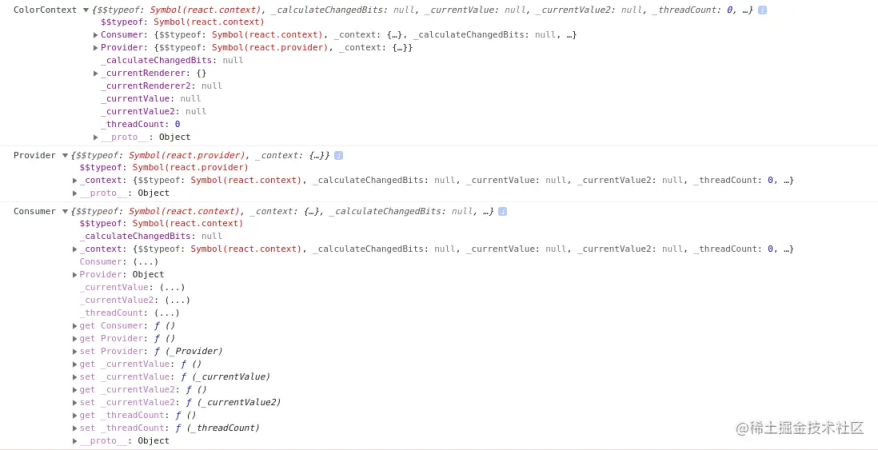
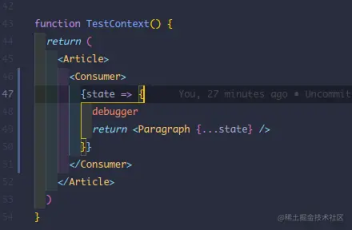
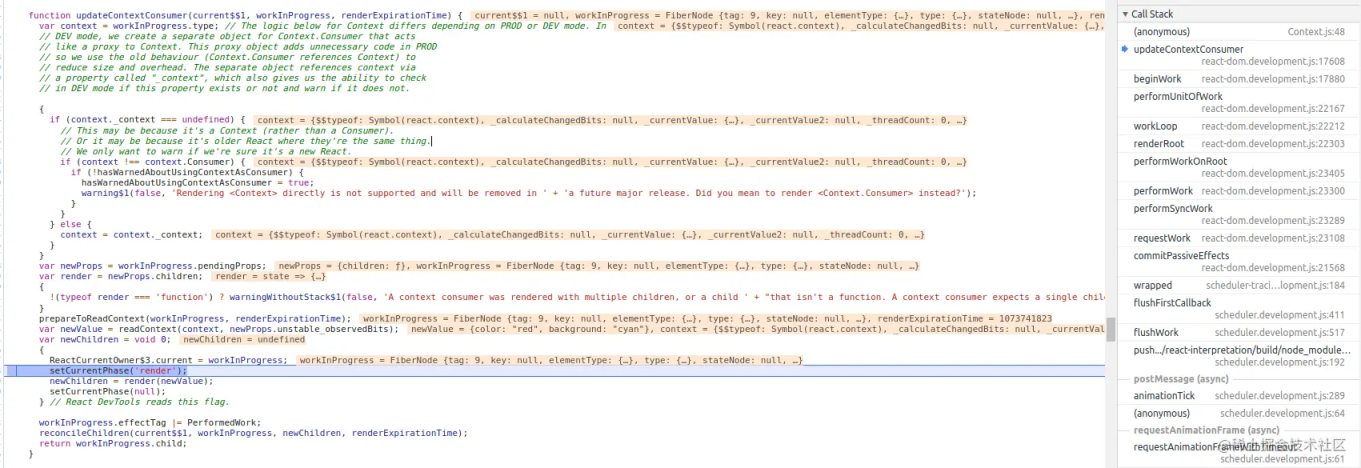
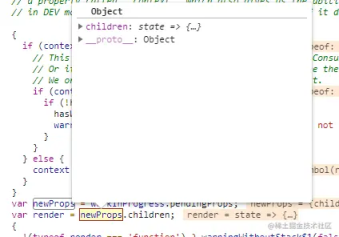



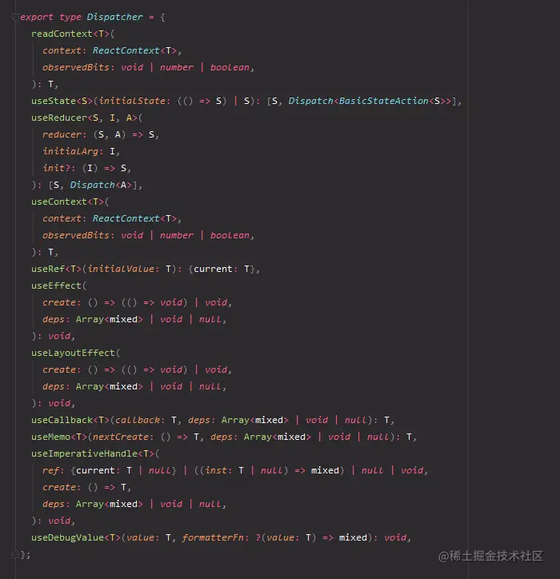














评论